-
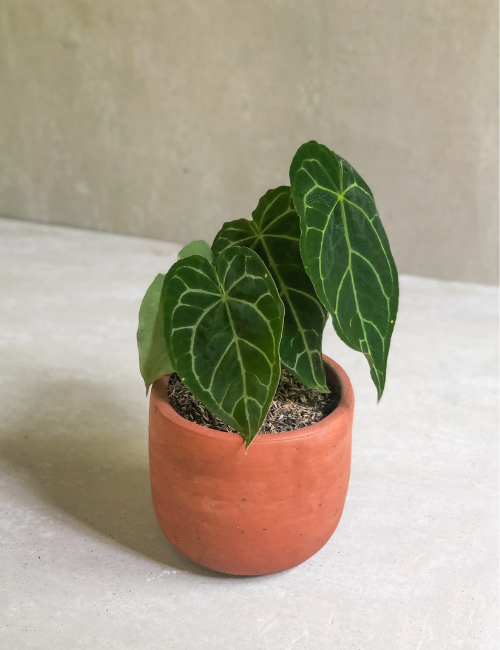 Anthurium Crystallinum in Terracota Pot. Native to Central and South America, the Anthurium Crystallinum is a heart-shaped evergreen with velvety foliage. The leaves of this beauty are dark green or reddish purple with deep, white veins that make it visually stand out. Anthuriums are widely enjoyed as outdoor plants in tropical gardens, but they also make excellent houseplants in the kitchen, patio, or living room. Full sun, partial shade 2-3 times a week
Anthurium Crystallinum in Terracota Pot. Native to Central and South America, the Anthurium Crystallinum is a heart-shaped evergreen with velvety foliage. The leaves of this beauty are dark green or reddish purple with deep, white veins that make it visually stand out. Anthuriums are widely enjoyed as outdoor plants in tropical gardens, but they also make excellent houseplants in the kitchen, patio, or living room. Full sun, partial shade 2-3 times a week -
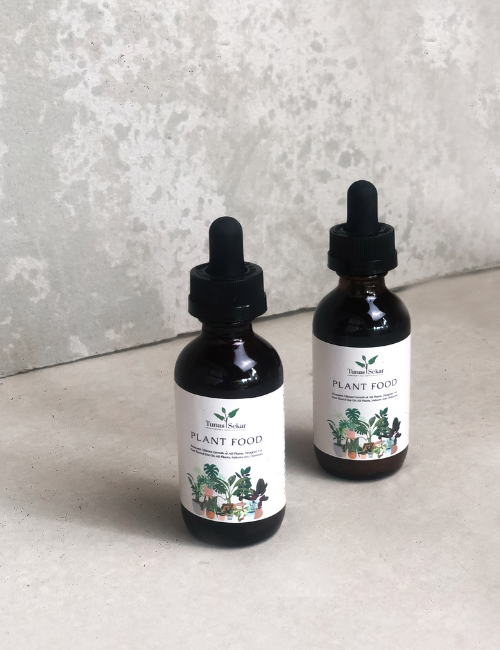 Plant Food Bundle This bundle contain 2 bottles of Plant Food to stock at home for your green friends! Promotes Vibrant Growth of All Plants, Designed For Year Round Use On All Plants, Indoors And Outdoors. This organic plant food will give your plants instant nutrients, promote root growth, special mix of nutrients encourages plants to grow twice as big, enhances natural immunity against insect and fungal attack and increase nutrients in the soil. How To Use: 1. Shake well before use 2. Mix 2 drops of plant food with 1 litre of water to a spray bottle or watering can 3. Best to spray before 10 AM and after 4 PM 4. Spray or add directly to the soil 5. You can add plant food every 7 days 6. Once you mix the plant food with water it need to be use within 24 hours 7. Keep away from children 8. Store in the cool place, avoid store it with direct sunlight ** This promotion only available via purchase on Tokopedia not applicable for in store purchase
Plant Food Bundle This bundle contain 2 bottles of Plant Food to stock at home for your green friends! Promotes Vibrant Growth of All Plants, Designed For Year Round Use On All Plants, Indoors And Outdoors. This organic plant food will give your plants instant nutrients, promote root growth, special mix of nutrients encourages plants to grow twice as big, enhances natural immunity against insect and fungal attack and increase nutrients in the soil. How To Use: 1. Shake well before use 2. Mix 2 drops of plant food with 1 litre of water to a spray bottle or watering can 3. Best to spray before 10 AM and after 4 PM 4. Spray or add directly to the soil 5. You can add plant food every 7 days 6. Once you mix the plant food with water it need to be use within 24 hours 7. Keep away from children 8. Store in the cool place, avoid store it with direct sunlight ** This promotion only available via purchase on Tokopedia not applicable for in store purchase -
Sale!

 Plant Life Chose Me! This box contain goodness for plant lovers, perfect for gift or a treat for your family & friends. This box contains:
Plant Life Chose Me! This box contain goodness for plant lovers, perfect for gift or a treat for your family & friends. This box contains:- 2X Plant Food
- 1X Leaf Shine
- Mini Gardening Tools
- 1X Soil Meter
-
 The Anthurium Jenmanii 'Lovely Green' is a strong, extremely strong foliage plant, ideal for offices. A fantastically beautiful plant that can simply stand in a shady place. Bright indirect light - shade tolerant 2 -3 times a week. Likes a warm humid spot, the roots should be left hanging exposed to the air and left on top of the mount. Aroids like well draining soil
The Anthurium Jenmanii 'Lovely Green' is a strong, extremely strong foliage plant, ideal for offices. A fantastically beautiful plant that can simply stand in a shady place. Bright indirect light - shade tolerant 2 -3 times a week. Likes a warm humid spot, the roots should be left hanging exposed to the air and left on top of the mount. Aroids like well draining soil -
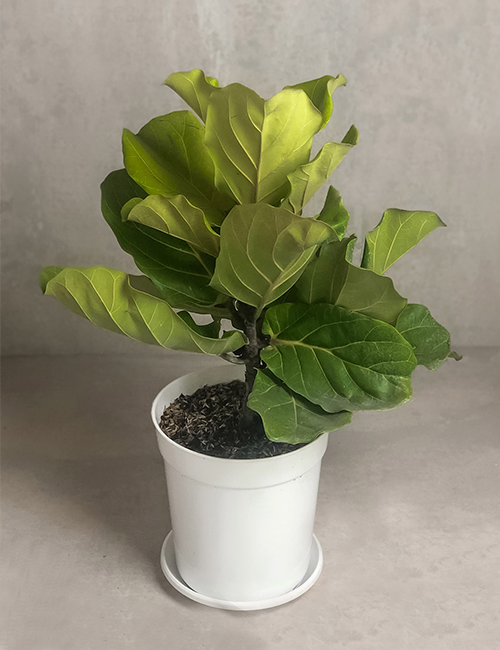 Native to the rainforests of western and central Africa, the Fiddle Leaf Fig Tree (Ficus lyrata) is a stunning plant with huge green leaves and an even larger following of houseplant fans. Fiddle leaf figs prefer lots of bright, filtered light. Keep your fiddle leaf fig near a sunny, east-facing window so it can take in lots of sunshine throughout the day. 2 -3 times a week. Wait for the top inch of your fiddle leaf fig tree’s soil to dry before you pick up your watering can.
Native to the rainforests of western and central Africa, the Fiddle Leaf Fig Tree (Ficus lyrata) is a stunning plant with huge green leaves and an even larger following of houseplant fans. Fiddle leaf figs prefer lots of bright, filtered light. Keep your fiddle leaf fig near a sunny, east-facing window so it can take in lots of sunshine throughout the day. 2 -3 times a week. Wait for the top inch of your fiddle leaf fig tree’s soil to dry before you pick up your watering can. -
 The official name of this plant is Epipremnum pinnatum, the name of the variety "Aureum". However, the plant is better known under the old name: Scindapsus aureum, simply "Scindapsus". The Scindapsus belongs to the Araceae family and is native to the forests of Southeast Asia, where the leaves of the climbing plant can grow up to 100 cm. The European variety is a youthful form of this plant. Diameter pot 25cm Semi-shade, no direct sunlight The soil of the Scindapsus should never be dry and should therefore always be kept slightly moist. The plant is also used to this naturally in the rainforests. Too much water is not good and therefore make sure that there is no layer of water at the bottom of the pot.
The official name of this plant is Epipremnum pinnatum, the name of the variety "Aureum". However, the plant is better known under the old name: Scindapsus aureum, simply "Scindapsus". The Scindapsus belongs to the Araceae family and is native to the forests of Southeast Asia, where the leaves of the climbing plant can grow up to 100 cm. The European variety is a youthful form of this plant. Diameter pot 25cm Semi-shade, no direct sunlight The soil of the Scindapsus should never be dry and should therefore always be kept slightly moist. The plant is also used to this naturally in the rainforests. Too much water is not good and therefore make sure that there is no layer of water at the bottom of the pot. -
 An Alocasia plant, native to Asia, is also called an Elephant Ear plant or African Mask plant because of their very large, glossy, heart-shaped leaves with wavy edges. These stunning, veined leaves come in red, bronze, blue-green, and purple. Proce include Alani Terracota M size Amazonica need bright indirect light to do their best. A little bit of morning sun or filtered sunlight is great, but keep this plant away from harsh, direct sunligh Allow the top 3-4 cm of soil to dry out before watering. Try to keep the soil evenly moist. Over-watering, wet leaves, and soggy soil makes an alocasia plant susceptible to a variety of serious fungal infections. Check the soil frequently until you are sure of the plant's watering needs
An Alocasia plant, native to Asia, is also called an Elephant Ear plant or African Mask plant because of their very large, glossy, heart-shaped leaves with wavy edges. These stunning, veined leaves come in red, bronze, blue-green, and purple. Proce include Alani Terracota M size Amazonica need bright indirect light to do their best. A little bit of morning sun or filtered sunlight is great, but keep this plant away from harsh, direct sunligh Allow the top 3-4 cm of soil to dry out before watering. Try to keep the soil evenly moist. Over-watering, wet leaves, and soggy soil makes an alocasia plant susceptible to a variety of serious fungal infections. Check the soil frequently until you are sure of the plant's watering needs -
 The plant originates from rainforests in Brazil and Argentina. In the Philodendron Bipennifolium’s natural habitat, it wraps itself around trees. The Philodendron Bipennifolium plant needs sunlight. But the plant’s leaves can’t take direct sunlight shining down on them. 2 -3 times a week. When watering your Philodendron Bipennifolium, you want the soil moist. But you don’t want the soil saturated.
The plant originates from rainforests in Brazil and Argentina. In the Philodendron Bipennifolium’s natural habitat, it wraps itself around trees. The Philodendron Bipennifolium plant needs sunlight. But the plant’s leaves can’t take direct sunlight shining down on them. 2 -3 times a week. When watering your Philodendron Bipennifolium, you want the soil moist. But you don’t want the soil saturated. -
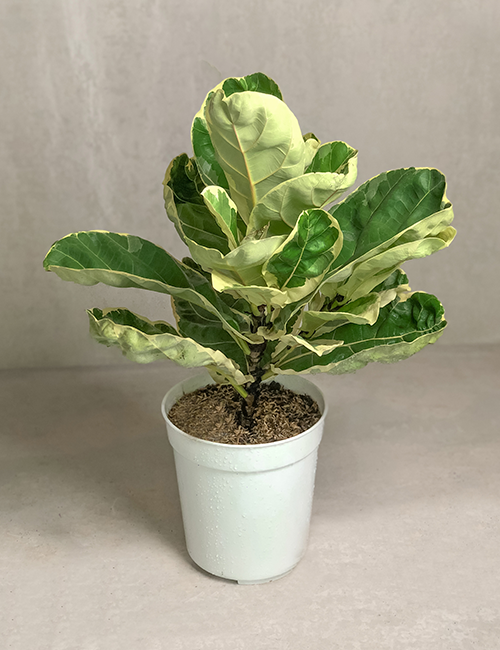 Native to the rainforests of western and central Africa, the Fiddle Leaf Fig Tree (Ficus lyrata) is a stunning plant with huge green leaves and an even larger following of houseplant fans. Fiddle leaf figs prefer lots of bright, filtered light. Keep your fiddle leaf fig near a sunny, east-facing window so it can take in lots of sunshine throughout the day. 2 -3 times a week. Wait for the top inch of your fiddle leaf fig tree’s soil to dry before you pick up your watering can.
Native to the rainforests of western and central Africa, the Fiddle Leaf Fig Tree (Ficus lyrata) is a stunning plant with huge green leaves and an even larger following of houseplant fans. Fiddle leaf figs prefer lots of bright, filtered light. Keep your fiddle leaf fig near a sunny, east-facing window so it can take in lots of sunshine throughout the day. 2 -3 times a week. Wait for the top inch of your fiddle leaf fig tree’s soil to dry before you pick up your watering can. -
 Calathea Majestica ‘White Star’ is a cultivar of the Ornata Species and one of the most elegant. With paint like white and pink stripes on the leaves, this calathea is a staple plant for the passionate collector. Added bonus: Calathea are not poisonous which means it’s pet friendly (non toxic to cats and dogs). Calathea love bright, indirect light Allow the soil to dry out halfway before watering. Typically when you see the surface of the soil is dry, it's safe to give them a water.
Calathea Majestica ‘White Star’ is a cultivar of the Ornata Species and one of the most elegant. With paint like white and pink stripes on the leaves, this calathea is a staple plant for the passionate collector. Added bonus: Calathea are not poisonous which means it’s pet friendly (non toxic to cats and dogs). Calathea love bright, indirect light Allow the soil to dry out halfway before watering. Typically when you see the surface of the soil is dry, it's safe to give them a water. -
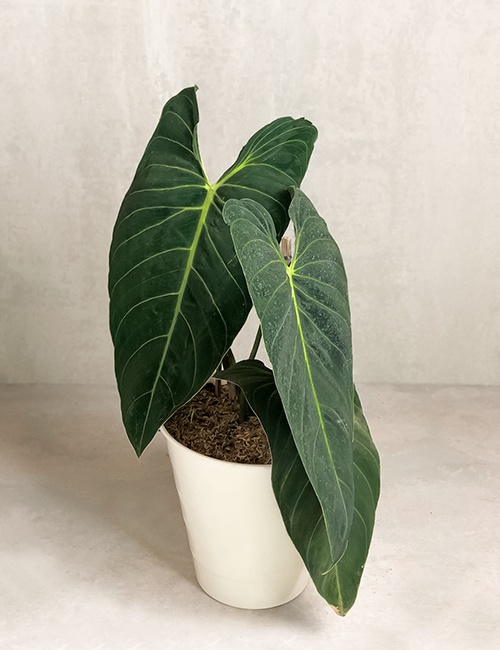 Melanochrysum is a large velvet leaf variety of philodendron whose leaves start out pink with light green veins and slowly matures into a deep dark green with a velvety texture. This plant does require a totem or some sort of pole to climb otherwise it will tendency to meander and droop. This is a superior variety philodendron which is quite easy to grow. Philodendron Melanochrysum enjoys bright shade. Bright shade stands for filtered sunlight or indirect bright light. Make sure that the soil never dries out. You will need to hydrate your plant all the time, but also avoid over-watering.
Melanochrysum is a large velvet leaf variety of philodendron whose leaves start out pink with light green veins and slowly matures into a deep dark green with a velvety texture. This plant does require a totem or some sort of pole to climb otherwise it will tendency to meander and droop. This is a superior variety philodendron which is quite easy to grow. Philodendron Melanochrysum enjoys bright shade. Bright shade stands for filtered sunlight or indirect bright light. Make sure that the soil never dries out. You will need to hydrate your plant all the time, but also avoid over-watering. -
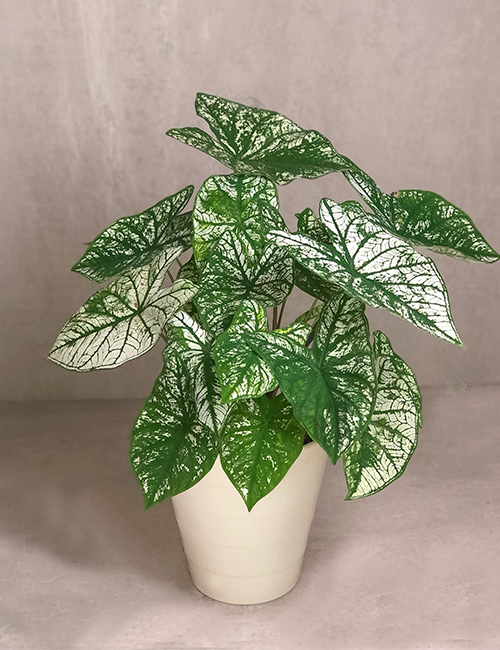 An outstanding variety producing luminous white leaves with contrasting dark green veins and lighter green edges; this one really stands out in a shaded area, and lends to show off other plants; a great container plant, indoors or out. The caladium prefers indirect light or moderate shade indoors. The narrower the leaves, the greater the sun it can withstand. When leaves appear on the plant, water as needed to keep the soil evenly moist. Never let the plant dry out.
An outstanding variety producing luminous white leaves with contrasting dark green veins and lighter green edges; this one really stands out in a shaded area, and lends to show off other plants; a great container plant, indoors or out. The caladium prefers indirect light or moderate shade indoors. The narrower the leaves, the greater the sun it can withstand. When leaves appear on the plant, water as needed to keep the soil evenly moist. Never let the plant dry out. -
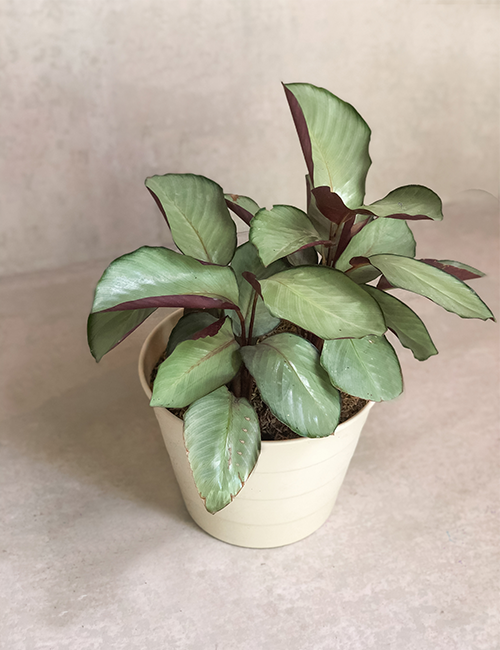 Calathea ‘Silver Plate’ has beautiful leaves which are uniformly glossy greenish-grey on top, purple below, sometimes with green margin, broadly ovate. Leaf stalks are purple that makes a wonderful indoor plant with decent look in your calathea collection. Bright but indirect light. Only water after Soil dries completely
Calathea ‘Silver Plate’ has beautiful leaves which are uniformly glossy greenish-grey on top, purple below, sometimes with green margin, broadly ovate. Leaf stalks are purple that makes a wonderful indoor plant with decent look in your calathea collection. Bright but indirect light. Only water after Soil dries completely -
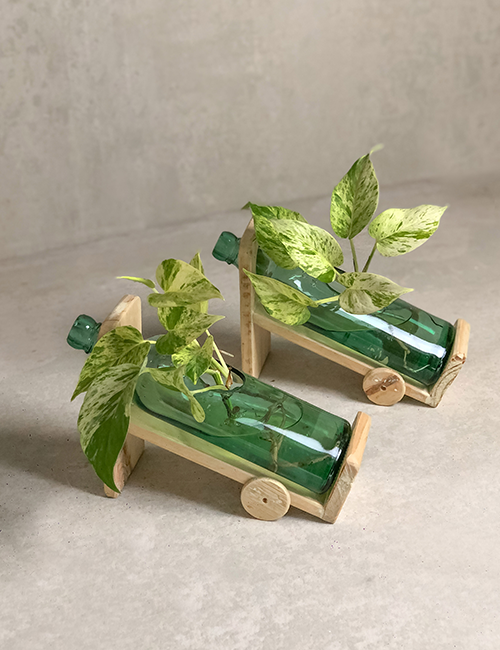 The pothos plant is considered by many to be a great way to get started caring for houseplants. Because pothos care in easy and undemanding, this lovely plant is an easy way to add some green in your home. To add up chic and unique essential to your home this Pothos in Recycle Bottle Frame will suit any corner and easy to care to just add water every 3- 4 days. Indoors, pothos prefers bright but indirect light. 3- 4 times a week, expect to water more often in brighter light and less often in lower light.
The pothos plant is considered by many to be a great way to get started caring for houseplants. Because pothos care in easy and undemanding, this lovely plant is an easy way to add some green in your home. To add up chic and unique essential to your home this Pothos in Recycle Bottle Frame will suit any corner and easy to care to just add water every 3- 4 days. Indoors, pothos prefers bright but indirect light. 3- 4 times a week, expect to water more often in brighter light and less often in lower light. -
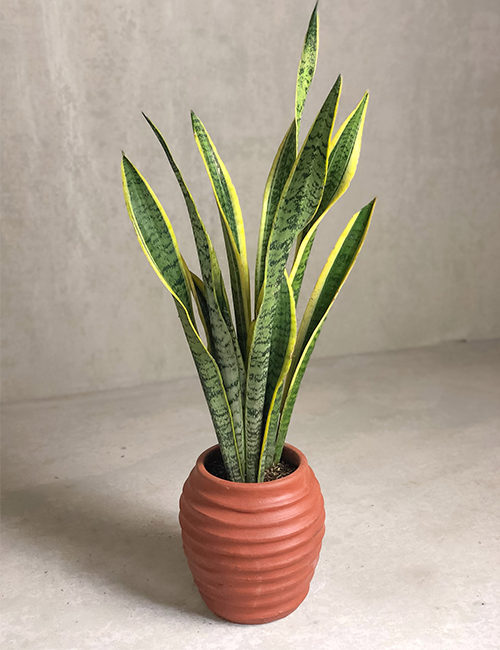 Sansevierias (Snake Plants) are some of the toughest plants you can find. Whether indoors, in your garden or on your balcony, these spiky beauties can put up with almost anything. Sansiviera prefer bright, indirect light and can even tolerate some direct sunlight. However, they also grow well (albeit more slowly) in shady corners and other low-light areas of the home. 3 -5 times a week depends on humidity of your room, please make sure to touch the soil before you water it.
Sansevierias (Snake Plants) are some of the toughest plants you can find. Whether indoors, in your garden or on your balcony, these spiky beauties can put up with almost anything. Sansiviera prefer bright, indirect light and can even tolerate some direct sunlight. However, they also grow well (albeit more slowly) in shady corners and other low-light areas of the home. 3 -5 times a week depends on humidity of your room, please make sure to touch the soil before you water it. -
 The ZZ (Zamioculcas zamiifolia), or Zanzibar Gem, is a semi-succulent native to the semi-arid regions of Eastern Africa. It is accustomed to long periods of dry conditions interspersed with bursts of generous rain Bright light is good but not essential. The zamioculcas zamiifolia grows fine with low levels of light, but it's best to avoid direct sunlight. Allow the soil to become dry at the top to the touch between watering and do not over water. It's best to water this plant less than too much because over-watering can cause stem and rhizome rot.
The ZZ (Zamioculcas zamiifolia), or Zanzibar Gem, is a semi-succulent native to the semi-arid regions of Eastern Africa. It is accustomed to long periods of dry conditions interspersed with bursts of generous rain Bright light is good but not essential. The zamioculcas zamiifolia grows fine with low levels of light, but it's best to avoid direct sunlight. Allow the soil to become dry at the top to the touch between watering and do not over water. It's best to water this plant less than too much because over-watering can cause stem and rhizome rot. -
 The elongated leaves of the Schefflera plant liken its shape to that of an umbrella. Thus its nickname, the Umbrella Tree, makes a lot of visual sense. The combination of its attractive leaves and detoxifying powers makes the Schefflera plant a very popular indoor plant. Our experts at Ambius know how popular the Schefflera plants are, and can help improve your business or office environment Schefflera plants prefer medium-light, meaning they should be kept in bright light, but the light should not be direct. The best advice is to water once the top soil becomes dry. Over-watering is more of a problem than lack of water.
The elongated leaves of the Schefflera plant liken its shape to that of an umbrella. Thus its nickname, the Umbrella Tree, makes a lot of visual sense. The combination of its attractive leaves and detoxifying powers makes the Schefflera plant a very popular indoor plant. Our experts at Ambius know how popular the Schefflera plants are, and can help improve your business or office environment Schefflera plants prefer medium-light, meaning they should be kept in bright light, but the light should not be direct. The best advice is to water once the top soil becomes dry. Over-watering is more of a problem than lack of water. -
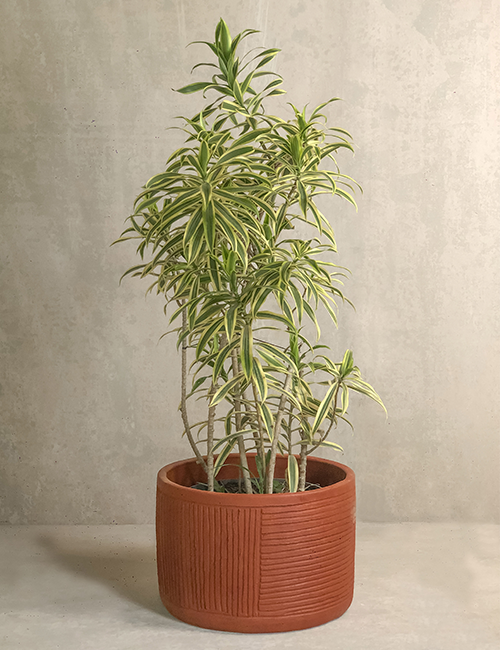 The Song of India variety of dracaena (Dracaena reflexa ‘Variegata’), also known as pleomele, is native to islands in the Indian Ocean near Madagascar. In the wild or in a garden with the right conditions, this dracaena will grow as tall as 5.5 meters, with a spread out to 2.5 meters Diameter pot 35cm Song of India needs bright, indirect light. Intense, direct sun will unfortunately burn the leaves and low light will cause the plant’s yellow-lime striped vibrancy to fade and the plant to turn spindly. Mild morning sun can be an option. 2-3 times a week, allow the top couple of inches to dry out before watering it thoroughly.
The Song of India variety of dracaena (Dracaena reflexa ‘Variegata’), also known as pleomele, is native to islands in the Indian Ocean near Madagascar. In the wild or in a garden with the right conditions, this dracaena will grow as tall as 5.5 meters, with a spread out to 2.5 meters Diameter pot 35cm Song of India needs bright, indirect light. Intense, direct sun will unfortunately burn the leaves and low light will cause the plant’s yellow-lime striped vibrancy to fade and the plant to turn spindly. Mild morning sun can be an option. 2-3 times a week, allow the top couple of inches to dry out before watering it thoroughly. -
 The official name of this plant is Epipremnum pinnatum, the name of the variety "Aureum". However, the plant is better known under the old name: Scindapsus aureum, simply "Scindapsus". The Scindapsus belongs to the Araceae family and is native to the forests of Southeast Asia, where the leaves of the climbing plant can grow up to 100 cm. The European variety is a youthful form of this plant. Diameter pot 25cm Semi-shade, no direct sunlight The soil of the Scindapsus should never be dry and should therefore always be kept slightly moist. The plant is also used to this naturally in the rainforests. Too much water is not good and therefore make sure that there is no layer of water at the bottom of the pot.
The official name of this plant is Epipremnum pinnatum, the name of the variety "Aureum". However, the plant is better known under the old name: Scindapsus aureum, simply "Scindapsus". The Scindapsus belongs to the Araceae family and is native to the forests of Southeast Asia, where the leaves of the climbing plant can grow up to 100 cm. The European variety is a youthful form of this plant. Diameter pot 25cm Semi-shade, no direct sunlight The soil of the Scindapsus should never be dry and should therefore always be kept slightly moist. The plant is also used to this naturally in the rainforests. Too much water is not good and therefore make sure that there is no layer of water at the bottom of the pot. -
 Potting Tarp These tarps were designed for re-potting your plants in small, indoor spaces or anywhere you don't want to make a mess. Made by recycled plastic, the fabric is highly UV, abrasion and water resistant. Equipped with snaps at each corner to fold up the tarp edges, this will help contain dirt while re-potting. Available in 2 sizes: Small: 65x65cm Large: 100X 100cm Black or White
Potting Tarp These tarps were designed for re-potting your plants in small, indoor spaces or anywhere you don't want to make a mess. Made by recycled plastic, the fabric is highly UV, abrasion and water resistant. Equipped with snaps at each corner to fold up the tarp edges, this will help contain dirt while re-potting. Available in 2 sizes: Small: 65x65cm Large: 100X 100cm Black or White -
 Unique cylindrical shape design, with soft candy color which add elegant style for your space. Long mouth design which is convenient to water all kinds of plants. Ergonomic handle is comfortable to hold.
Unique cylindrical shape design, with soft candy color which add elegant style for your space. Long mouth design which is convenient to water all kinds of plants. Ergonomic handle is comfortable to hold. -
 Plant Care Bundle A must have combo for your green friend at home. This bundle contain 1X Leaf Shine and 1X Plant Food suitable to use on all indoor plant
Plant Care Bundle A must have combo for your green friend at home. This bundle contain 1X Leaf Shine and 1X Plant Food suitable to use on all indoor plant -
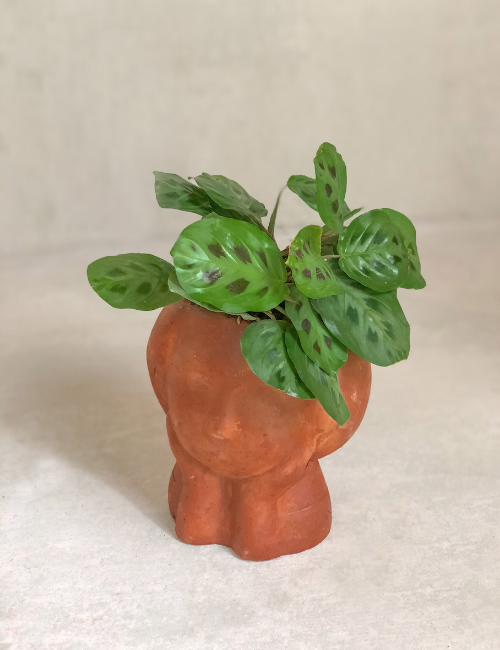 Calathea Maranta Leuconeura in Wonder Terracotta Calathea Maranta Leuconeura ‘Kim’ is a purple-spotted variety of prayer plant. Aside from the purple spots, the leaves have a cream-white streak for extra flair. Native to the tropical forests of Brazil, prayer plants are some of the most beautiful indoor houseplants you can find. They’re great in hanging baskets as they spread low and wide You can hang or set your prayer plant near a window where it will receive indirect sunlight. Never set your plant in direct sunlight because the sun will scorch the plant’s leaves or the leaves will develop blotches or patches and fade in color intensity. 2-3 times a week. Water the prayer plant when the top of the potting soil is just starting to become dry. These plants are very susceptible to drought; however, to avoid fungal problems, do not let water sit directly on the leaves or let the plant get soggy.
Calathea Maranta Leuconeura in Wonder Terracotta Calathea Maranta Leuconeura ‘Kim’ is a purple-spotted variety of prayer plant. Aside from the purple spots, the leaves have a cream-white streak for extra flair. Native to the tropical forests of Brazil, prayer plants are some of the most beautiful indoor houseplants you can find. They’re great in hanging baskets as they spread low and wide You can hang or set your prayer plant near a window where it will receive indirect sunlight. Never set your plant in direct sunlight because the sun will scorch the plant’s leaves or the leaves will develop blotches or patches and fade in color intensity. 2-3 times a week. Water the prayer plant when the top of the potting soil is just starting to become dry. These plants are very susceptible to drought; however, to avoid fungal problems, do not let water sit directly on the leaves or let the plant get soggy. -
 Potting Mix. 2000 gram. * For all indoor and outdoor containers * Improve moisture retention and reduce drought stress * Rich with organic fertilizer * Blended for a wide variety of container plants * Promotes root growth
Potting Mix. 2000 gram. * For all indoor and outdoor containers * Improve moisture retention and reduce drought stress * Rich with organic fertilizer * Blended for a wide variety of container plants * Promotes root growth -
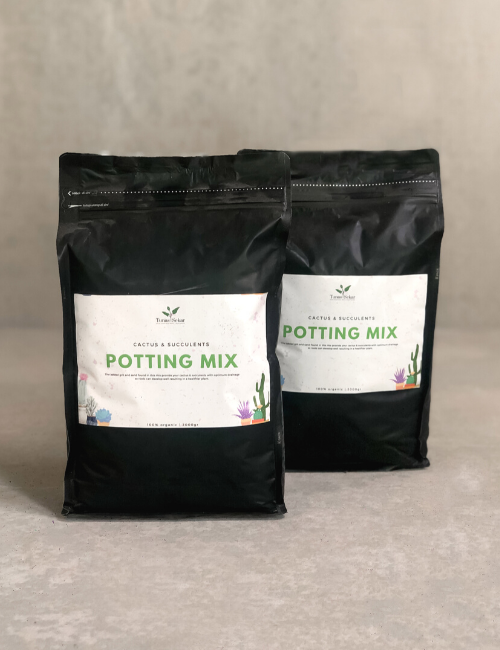 Potting Mix Succulents. 2500 gram. The added grit and sand found in this mix provide your cactus & succulents with optimum drainage so roots can develop well resulting in a healthier plant.
Potting Mix Succulents. 2500 gram. The added grit and sand found in this mix provide your cactus & succulents with optimum drainage so roots can develop well resulting in a healthier plant. -
 Hydroton. 500 gram. Horticultural clay pebbles are made from 100% natural clay. Clay pebbles are unique,lightweight expanded clay aggregate and porous which holds air in them and increases the aeration for the root system of the plant. The structural formation of these hydrotons is such that it is light in weight and has enough space inside to capture the air and let it release whenever the plants or harvest needs it.
Hydroton. 500 gram. Horticultural clay pebbles are made from 100% natural clay. Clay pebbles are unique,lightweight expanded clay aggregate and porous which holds air in them and increases the aeration for the root system of the plant. The structural formation of these hydrotons is such that it is light in weight and has enough space inside to capture the air and let it release whenever the plants or harvest needs it. -
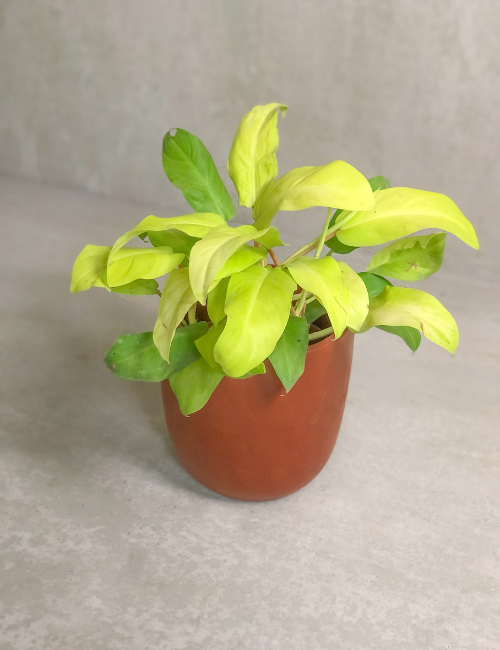
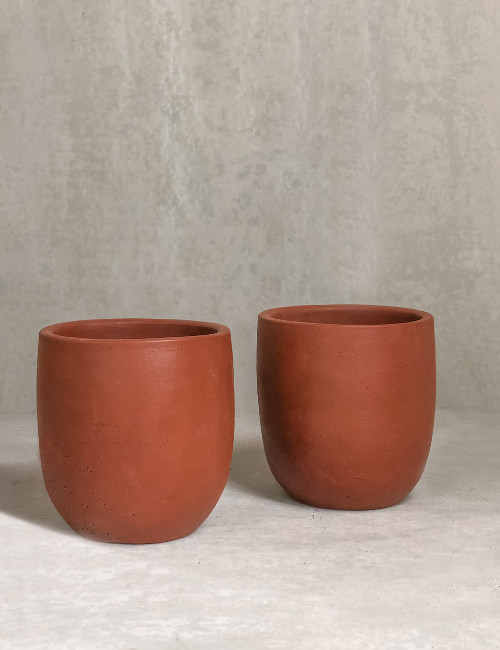 Oval Terracotta. Give your plants and home a facelift by adding new pots to your plants. Enhance a style or season, or have fun with a new splash of color in the room. Diameter 18 cm. Height 20cm.
Oval Terracotta. Give your plants and home a facelift by adding new pots to your plants. Enhance a style or season, or have fun with a new splash of color in the room. Diameter 18 cm. Height 20cm. -
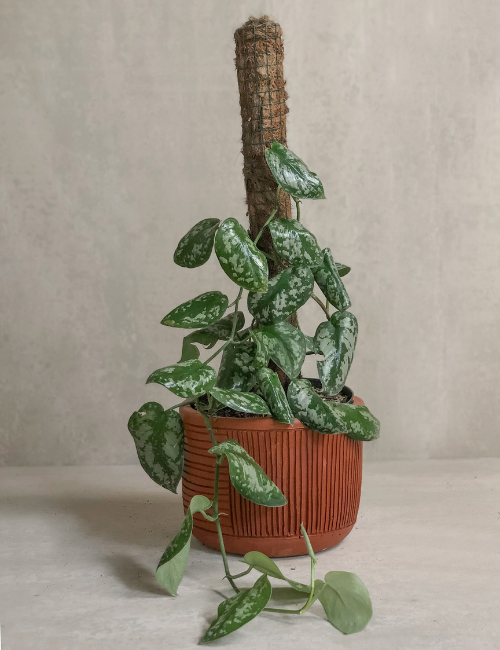
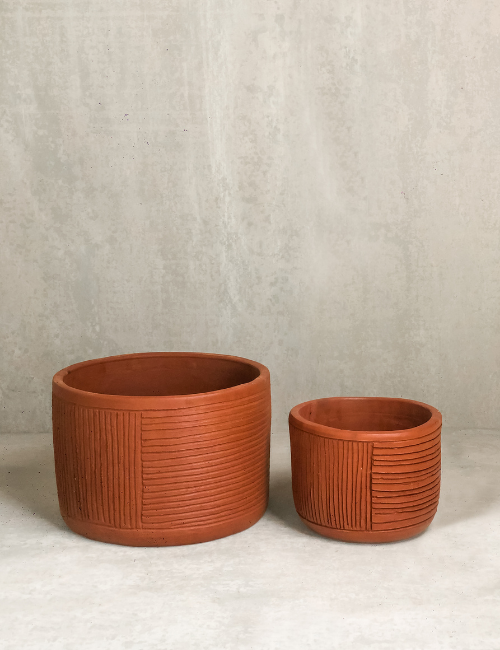 Dala Terracotta. To create a cozy atmosphere in your garden, it is not only the outdoor furniture that is important, but also the accessories you utilise. A stylish accessory is a sculpture or pot. Dala Terracotta pots are handmade in Indonesia perfect for any plants in your home.
Dala Terracotta. To create a cozy atmosphere in your garden, it is not only the outdoor furniture that is important, but also the accessories you utilise. A stylish accessory is a sculpture or pot. Dala Terracotta pots are handmade in Indonesia perfect for any plants in your home. -
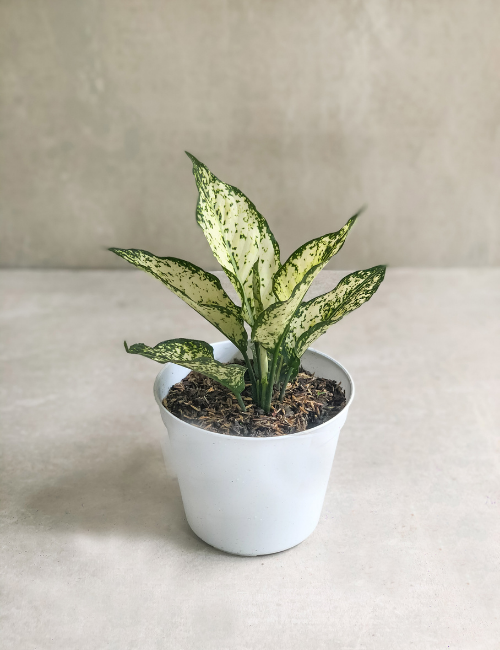 Aglaonema Snow White. Aglaonema, also known as Chinese Evergreen, is a highly decorative plant with several interesting varieties. It is one of the most popular houseplants and the colour variations—from dark green to silver, and some with hints of red—add to your home's decor. The darker green varieties of aglaonema can grow in near shade, while the variegated varieties require brighter light. Do not expose any variety of aglaonema to direct sun. 2-3 times a week, do not let the plant dry out completely.
Aglaonema Snow White. Aglaonema, also known as Chinese Evergreen, is a highly decorative plant with several interesting varieties. It is one of the most popular houseplants and the colour variations—from dark green to silver, and some with hints of red—add to your home's decor. The darker green varieties of aglaonema can grow in near shade, while the variegated varieties require brighter light. Do not expose any variety of aglaonema to direct sun. 2-3 times a week, do not let the plant dry out completely. -
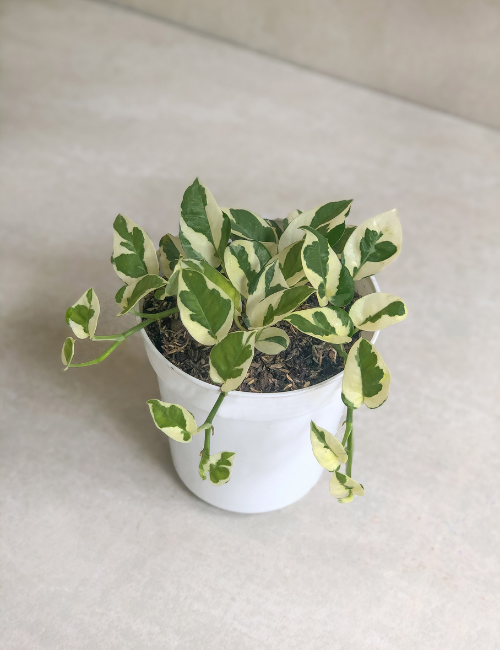 Pothos N'Joy. The tender leaves are fresh and are appealing, this plant unlike other pothos is not a fast grower, the color combination of so magnificent that you cannot move your eyes away from the plant. They love bright indirect light and no harm if exposed to morning sun but make sure that the plant is not exposed to harsh sun light as this may burn the leaves. 2-3 times a week. The Pothos N-joy grows best in moist soil be careful not to overwater it.
Pothos N'Joy. The tender leaves are fresh and are appealing, this plant unlike other pothos is not a fast grower, the color combination of so magnificent that you cannot move your eyes away from the plant. They love bright indirect light and no harm if exposed to morning sun but make sure that the plant is not exposed to harsh sun light as this may burn the leaves. 2-3 times a week. The Pothos N-joy grows best in moist soil be careful not to overwater it. -
 Anthurium Laceleaf. The red oval spathes of a flamingo flower & Laceleaf make it really distinguishable. The flowers grow on orange spadix and grow densely. The heart-shaped flowers are actually morphed leaves and called spathes. The lifeline of spathes is about 8 weeks. The flowers are small in size and perfect in shape, hence, are deemed to be true flowers. The leaves of this flower can grow up to 18 cm long and twirl around the main stem. Indirect bright light is best for your plants. If you want your Anthurium plant to thrive and bloom properly, that’s the way to go about. In the absence of proper light, the plant can become spindly as it tries to reach out for light. Please note that anthurium requires indirect light and if you place it in direct sunlight, the leaves can develop brown edges due to sunburn. Let the topmost layer dry up to two inches before you water it again. Overwatering can cause root rot while not watering the plant properly can cause brown tips on leaves. However, the pot should be well-drained and there should be an arrangement to drain excess water.
Anthurium Laceleaf. The red oval spathes of a flamingo flower & Laceleaf make it really distinguishable. The flowers grow on orange spadix and grow densely. The heart-shaped flowers are actually morphed leaves and called spathes. The lifeline of spathes is about 8 weeks. The flowers are small in size and perfect in shape, hence, are deemed to be true flowers. The leaves of this flower can grow up to 18 cm long and twirl around the main stem. Indirect bright light is best for your plants. If you want your Anthurium plant to thrive and bloom properly, that’s the way to go about. In the absence of proper light, the plant can become spindly as it tries to reach out for light. Please note that anthurium requires indirect light and if you place it in direct sunlight, the leaves can develop brown edges due to sunburn. Let the topmost layer dry up to two inches before you water it again. Overwatering can cause root rot while not watering the plant properly can cause brown tips on leaves. However, the pot should be well-drained and there should be an arrangement to drain excess water. -
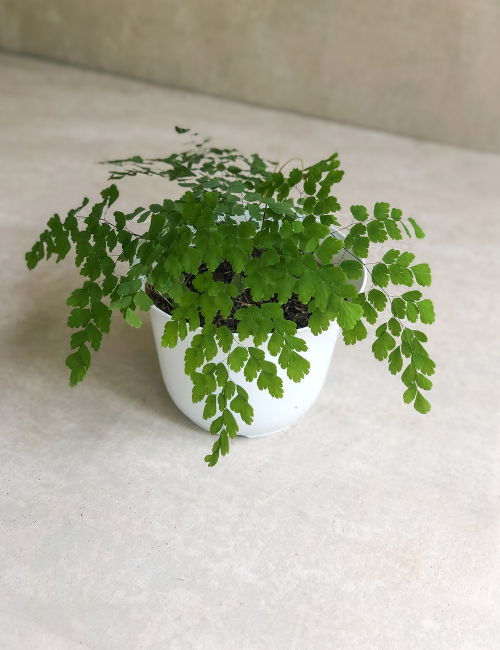 Maidenhair Fern. Maidenhair ferns have delicate fan-shaped leaf segments, typically clustered on wiry black stems. In addition to being a popular houseplant, maidenhair fern can also be found in nature, growing in places where other plants typically don't, like on rock walls and in between rock fissures where the moisture from water seepage keeps them alive. Prefers bright indirect light, avoid harsh direct sunlight that may burn your plant’s leaves. 2-3 times a week. Water sparingly, making the potting mixture barely moist and allowing the top third to dry out before watering again.
Maidenhair Fern. Maidenhair ferns have delicate fan-shaped leaf segments, typically clustered on wiry black stems. In addition to being a popular houseplant, maidenhair fern can also be found in nature, growing in places where other plants typically don't, like on rock walls and in between rock fissures where the moisture from water seepage keeps them alive. Prefers bright indirect light, avoid harsh direct sunlight that may burn your plant’s leaves. 2-3 times a week. Water sparingly, making the potting mixture barely moist and allowing the top third to dry out before watering again.
